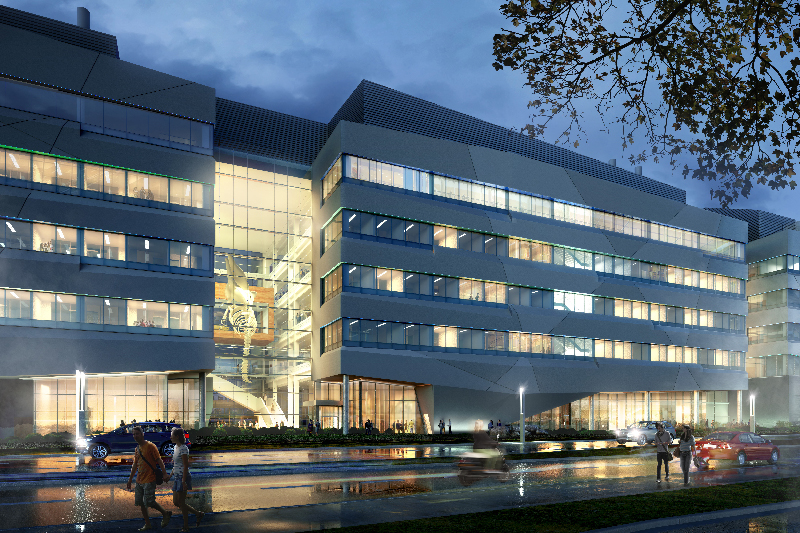Constructing the future of Memorial’s campuses
In recent months, the arrival of two cranes and dozens of workers at the site of the Core Science Facility on the St. John’s campus has been attracting attention.
The project was given the go-ahead in April to begin the third stage of the construction process.
In addition to the cranes, this past summer saw the arrival of tonnes of steel that is rapidly taking shape and is providing a glimpse of the magnitude of the facility.
When it opens, this state-of-the-art, 480,000-square-foot building will significantly advance Memorial’s teaching, learning and research capacity across multiple disciplines.
“The Core Science worksite currently stands as the flagship infrastructure project at Memorial, but it is by no means the limit of activities underway to improve and expand our infrastructure,” said Kent Decker, vice-president (administration and finance). “Memorial has an aggressive infrastructure plan.”
An updated plan was issued this year that provides details through to 2023. The revisions reflect the current economic realities as well as the current conditions of Memorial’s facilities.

Rendering of the Core Science Facility showing the blue whale skeleton that will hang in the new building as an educational and cultural artifact.
“Despite our challenges, we are excited to see the work that is happening around Memorial’s campuses to improve the student, faculty, staff and visitor experience with our facilities,” said Mr. Decker. “Finding innovative solutions during these tough economic times is necessary to push major projects forward.”
Strategic partnerships with the federal government, provincial government, private sector and the university community are allowing Memorial to make progress.
In addition to the unprecedented $125 million in joint federal-provincial funding that the Core Science Facility received, many other projects are benefiting from innovative funding arrangements.
The Battery Facility is on schedule and on budget for completion in 2018. The facility benefited from $4.1 million in federal funding through the Post-Secondary Institutions Strategic Investment Fund (SIF) and $4.5 million from Atlantic Canada Opportunities Agency. This is an example of a project that has no impact on the university’s operating budget, but has significant revenue generation potential. Once complete, the Battery Facility will provide a multi-use public engagement and innovation space. Significant activity is underway at the site, including work this past year to demolish the original city and pool wings and continued upgrades to the conference centre and office tower.
In June Memorial signed an agreement with Honeywell that moved the university into the second phase of an energy performance contract that will save energy and reduce the university’s utility costs. The projects associated with this agreement are scheduled for the St. John’s and Grenfell campuses. It focuses on energy-efficient solutions designed to upgrade facilities, reduce operating costs, improve indoor air quality and reduce environmental emissions. The program, valued at $28.4 million, is funded through energy savings with both the capital cost and energy savings guaranteed by Honeywell. A targeted $6 million of critical deferred maintenance will be addressed through this work.
The Animal Resource Centre’s construction has been high on Memorial’s infrastructure priority list and is a much-needed replacement for the university’s current animal research care facilities. The project was initiated in August with the signing of the construction contract. The new facility is critical to ensure Memorial sustains viable biomedical research activities and the certification of degree programs at Memorial. The global project budget is $35.6 million. The Government of Canada, through SIF, is providing support of $14.4 million.
Memorial continues to fund its annual Deferred Maintenance Program targeting aged infrastructure replacement.
“Over the past five years the university has provided more than $40 million toward critical infrastructure renewal, which includes roofing, door and window replacements, accessibility upgrades, electrical distribution and mechanical equipment replacement,” said Ann Browne, associate vice-president (facilities). “The university will continue to monitor and prioritize its deferred maintenance requirements in the coming years.”
Memorial’s infrastructure extends beyond the bricks, mortar and steel. Substantial infrastructure requirements relate to information technology (IT). IT infrastructure serves students, researchers, faculty and staff across the broad university community. Information Technology Services (ITS) at Memorial is dedicated to maintaining and growing the wireless and wired networks, strengthening the security infrastructure, ensuring IT equipment is maintained and renewed and providing updated data centre capacity. Recent work to the network in the residences on the St. John’s campus more than doubled the wireless capacity to provide faster, more reliable service for residents. Additionally, the project and new service delivery model allowed the ITS team to repurpose $600,000 of equipment to other areas of the institution and reduce its ongoing capital requirements, allowing the university to do more with available resources.
“In a university looking toward research intensity, ongoing investment in IT infrastructure is essential,” said Mr. Decker.
“As we look forward to 2020 and beyond, we are eager to see the infrastructure improvements that are in the works,” said Mr. Decker. “The private and public partnerships are assisting Memorial to implement this critical work that will benefit the students of Memorial into the future.”
This is just one of the many stories we have to tell about the transformative infrastructure improvements taking place across all Memorial campuses.